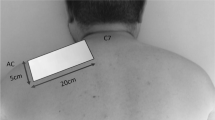Abstract
Previous studies about the usefulness of traction therapy have concluded with conflicting results. The aim of this study was to examine its efficacy in chronic neck pain. Forty-two patients with at least 6 weeks of nonspecific neck pain were selected for the study. Data about demographic characteristics including age, sex, body mass index, duration of cervical pain, working status, smoking status, and regular exercise were recorded. Each patient was randomly assigned to Group 1—receiving only standard physical therapy including hot pack, ultrasound therapy and exercise program and Group 2—treated with traction therapy in addition to standard physical therapy. The patients were reevaluated at the end of the therapy. The main outcome measures of the treatment were pain intensity by visual analog scale (VAS), disability by neck disability index (NDI), and quality of life assessed by Nottingham Health Profile (NHP). Twenty-four female and 18 male patients with mean age of 48.2 ± 11.5 years and a mean disease duration of 4.3 ± 2.9 years were included to the study. There were no differences between the groups in terms of age, sex, pain intensity, and scores of NHP and NDI at entry. There were 21 patients in both groups. Both groups improved significantly in pain intensity and the scores of NDI and physical subscles of NHP at the end of the therapies (p < 0.05). There was an association between NDI and VAS pain scores in both groups (p < 0.05). No correlation was observed between clinical variables and age and duration of disease. In conclusion, no specific effect of traction over standard physiotherapeutic interventions was observed in adults with chronic neck pain. We suggest the clinicians to consider this condition and to focus on exercise therapy in the management of patients suffering from this condition.
Similar content being viewed by others
References
Bovim G, Schrader H, Sand T (1994) Neck pain in the general population. Spine 19:1307–09
Moffett JAK, Jackson DA, Richmond S et al (2005) Randomised trial of a brief physiotherapy intervention compared with usual physiotherapy for neck pain patients: outcomes and patients’ preference. BMJ 330:75–81
Kjellman G, Öberg B (2002) A randomized clinical trial comparing general exercise, McKenzie treatment and a control group in patients with neck pain. J Rehabil Med 34:183–190
Malanga GA (1997) The diagnosis and treatment of cervical radiculopathy. Med Sci Sports Exerc 29(7 Suppl):S236–S245
Gross A, Aker P, Goldsmith C, Peloso P (2000) Physical medicine modalities for mechanical neck disorders. Cochrane Database Syst Rev 2:CD000961
Olivero WC, Dulebohn SC (2002) Results of halter cervical traction for the treatment of cervical radiculopathy: retrospective review of 81 patients. Neurosurg Focus 12(2):1–3
Graham N, Gross AR, Goldsmith C (2006) Mechanical traction for mechanical neck disorders: A systematic review. J Rehab Med 38:145–157
Wieting JM, Andary MT, Holmes TG et al (2005) In: De Lisa JA, Cans BM (eds) Physical Medicine and Rehabilitation: Principles and Practice. 4th edn. Lippincott, Philadelphia, pp 285–309
Zylbergold RS, Piper MC (1985) Cervical spine disorders: a comparison of three types of traction. Spine 10:867–71
Goldie I, Landquist A (1970) Evaluation of the effects of different forms of physiotherapy in cervical pain. Scand J Rehabil Med 2–3:117
Ackelman BH, Lindgren U (2002) Validity and reliability of a modified version of the neck disability index. J Rehabil Med 34:284–287
Kose G, Hepguler S, Atamaz M, Oder G (2007) A comparison of four disability scales for Turkish patients with neck pain. J Rehabil Med 39:358–362
Kucukdeveci AA, McKenna SP, Kutlay S et al (2000) The development and psychometric assessment of the Turkish version of the Nottingham Health Profile. Int J Rehabil Res 23:31–8
Persson LC, Lilia A (2001) Pain, coping, emotional state and physical function in patients with chronic radicular neck pain. A comparison between patients treated with surgery, physiotherapy or neck collar-a blinded prospective randomized study. Disabil Rehabil 23:325–335
Jordan A, Bendix T, Nielsen H et al (1998) Intensive training, physiotherapy, or manipulation for patients with chronic neck apin. A prospective, single-blinded, randomized clinical trial. Spine 23:311–318
Bronfort G, Evans R, Nelson B et al (2001) A randomized clinical trial of exercise and spinal manipulation for patients with chronic neck pain. Spine 26(7):788–797
Basford JR (1998) Physical agents. In: De Lisa JA (ed) Rehabilitation medicine, principles and practice. 3rd edn. Lippincot, Philadelphia, pp 483–503
Disclosures
None
Author information
Authors and Affiliations
Corresponding author
Rights and permissions
About this article
Cite this article
Borman, P., Keskin, D., Ekici, B. et al. The efficacy of intermittent cervical traction in patents with chronic neck pain. Clin Rheumatol 27, 1249–1253 (2008). https://doi.org/10.1007/s10067-008-0895-z
Received:
Revised:
Accepted:
Published:
Issue Date:
DOI: https://doi.org/10.1007/s10067-008-0895-z




